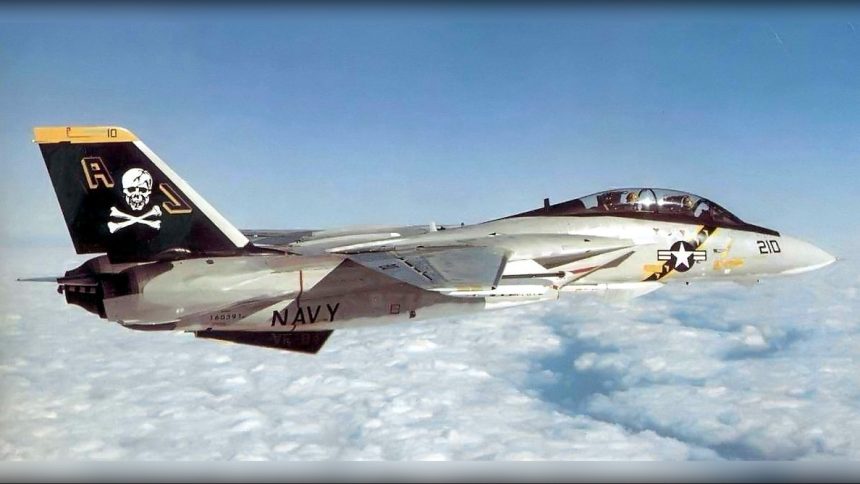The final member of the Grumman cat family, the F-14 Tomcat, with its signature variable-geometry wings and twin-engine design, became an iconic symbol of the Cold War.
Creating the Cat
A product of the “Grumman Iron Works” (Grumman Corp.), famous for producing rugged fighter aircraft such as the F4F Wildcat and F6F Hellcat during World War Two, the F-14 is a variable-geometry twin-engine all-weather interceptor/air-superiority fighter built under the newer company name of Grumman Aerospace Corporation.
When a program known as TFX (Tactical Fighter Experimental), established by Defense Secretary Robert McNamara, produced a naval version of the highly-touted Air Force F-111A, it soon became obvious the aircraft was not going to live up to requirements or expectations as a replacement for the Navy’s McDonnell Douglas F-4. Soon after McNamara left office, the too heavy General Dynamics-Grumman F-111B naval version was forgotten.
In July 1968 the Navy requested proposals on a new carrier-based fleet defense aircraft under a program known as Naval Fighter Experimental (VFX). Designs came from General Dynamics, North American Rockwell, Ling-Temco-Vought (LTV), McDonnell Douglas, and Grumman. Grumman was announced the winner of the design competition in Jan. 1969 with the company’s Model 303 proposal.
Grumman’s Model 303 design was a two-seat design and was built around a weapons system known as the Hughes AWG-9. Two Pratt & Whitney TF-30 turbofans would power the large aircraft, and, following Grumman’s tradition of naming aircraft after cats, the new aircraft became known as the F-14 “Tomcat” and would be the last “cat” produced by Grumman, with the first flight taking place on Dec. 21, 1970.
The F-14 was the first of the Teen Series of fighters for the United States, and was designed to establish complete air superiority in the vicinity of carrier battle groups at sea, perform interceptor duties, reconnaissance missions, as well as a secondary role attacking tactical targets. The variable-geometry wings adjusted automatically between 20 and 68 degrees, sweeping back for intercepting at high-speeds, and swung forward for lower speeds used for loitering and increased endurance during patrol duties. The rugged landing gear was designed to withstand carrier operations for the heaviest and largest U.S. fighter ever built for carrier operations.
After completing carrier trials in the summer of 1972, deliveries of the aircraft, now designated the F-14A, followed in Oct. of that year with the commissioning of the first two F-14 squadrons, VF-1 and VF-2. The F-14 would go to sea as an operational aircraft for the first time aboard the carrier USS Enterprise on Sept. 17, 1974.
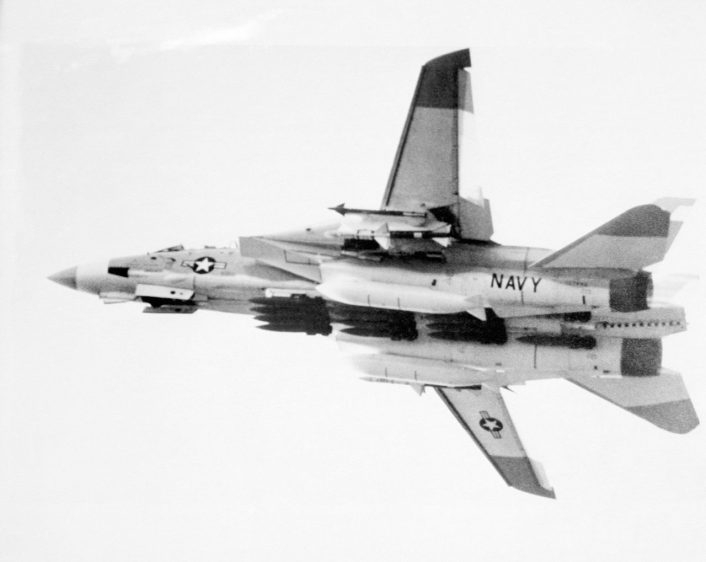
The Claws of the Cat
The heart of the F-14’s ability to perform its fleet defense missions was the Hughes AN/AWG-9 weapons control system, which could track up to 24 targets at once and allow 6 of them to be fired upon simultaneously. With roots in the Douglas F6D Missileer and the F-111B, the system and its powerful radar had look-down capabilities exceeding 150 miles and, combined with the AIM-54 Phoenix air-to-air (AAM) missile, the Tomcat was the perfect weapon for interception of long-range threats to naval assets.
The AIM-54 could carry a 132 lb warhead at speeds up to Mach 5 at a range over 125 miles, providing air defense of the fleet over an area consisting of 12,000 square miles at altitudes from near sea level to altitudes attained by aircraft and tactical missiles. An incredibly expensive missile, it was also very effective, carrying its own radar guidance system, allowing the F-14 to concentrate on and engage multiple threats. The AIM-54 was a large missile with a length of 13 ft, wingspan of 3 ft and weighing close to 1,000 lb. The F-14 could carry up to six Phoenix missiles, but normally was loaded in smaller quantities of two or four with a combination of other AAMs.
Medium range AIM-7 Sparrow missiles could also be carried by the Tomcat for BVR (Beyond Visual Range) aerial targets, as well as shorter range AIM-9 Sidewinder for closer targets. Racks allowed various combinations of “iron bombs” to be attached to the aircraft. Multiple weapons loading schemes allowed the F-14 to be configured for a variety of roles defending the fleet against aerial threats at various ranges or attacking ground targets, with a capacity for a mixture of ordinance of up to 14,500 lb. Drop tanks could also be thrown into the mix to extend range.
For close-in engagements the Tomcat also had a General Electric M61A-1 Vulcan 20 mm rotary cannon mounted in the forward fuselage on the left side. A total of 675 rounds were available for the Gatling-style gun capable of a rate of fire of up to 6,000 rounds per minute with a muzzle velocity around 3,400 feet per second (FPS).
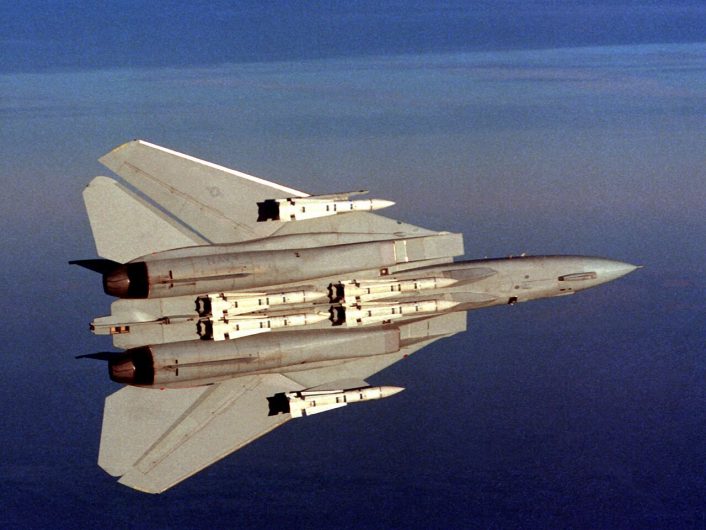
F-14 Specifications and Variants
Grumman F-14A models were supplied to the United States Navy totaling 478 in number. The A variant was powered by two Pratt & Whitney TF30-P-412A afterburning turbofans producing up to 20,900 lb of thrust each and giving the aircraft a maximum speed of Mach 2.34. Maximum wingspan was 64 ft 1.5 in and 38 ft 2.5 in at the maximum swept position. Service ceiling was 56,000 ft. Overall length was 62 ft with a height of 16 ft. Maximum take-off weight was 74,349 lb. A crew of two consisting of a pilot and a rear seat officer known as a RIO (Radar Intercept Officer), or sometimes called NFO (Naval Flying Officer), sat in tandem with good visibility.
An F-14B model was proposed utilizing the Pratt & Whitney F401-PW turbofans with a prototype produced from an existing F-14A and known as the “Super Tomcat”, but was placed in storage after a handful of flights. It would be used later a testbed for the General Electric F110-GE-400 engines producing 28,200 lb of thrust with good results. Later, some F-14A models were fitted with General Electric F110-GE-400 engines, designated F-14A+ and eventually re-designated the F-14B in May 1991. The new engines were more fuel efficient and also increased performance. These Tomcats received the ALR-67 Radar Homing and Warning (RHAW) system along with other upgrades.
An F-14C variant was proposed powered by two General Electric F101DFE engines along with improvements in avionics, radar, and fire control systems. However, the C model was never produced and most of these improvements were incorporated into later production F-14As, F-14A+(B), and eventually the F-14D.
The final Tomcat variant was the F-14D, with a total of 37 being produced before further production being stopped by Defense Secretary Dick Cheney in 1989. An additional 18 F-14As were converted to the F-14D.
Notable upgrades to the F-14 throughout its service life include the TARPS (Tactical Airborne Reconnaissance Pod System) controlled by the RIO, which included an extra display for viewing reconnaissance data, allowing the Tomcat to assume the role of the retiring Vought RF-8G Crusader. The Low Altitude Navigation and Targeting Infrared for Night (LANTIRN) gave the F-14 a forward-looking infrared (FLIR) camera for nocturnal operations along with a laser target designator for guiding laser-guided munitions. Ground attack capabilities improved in the 1990’s with the addition of the Joint Direct Attack Munition (JDAM) system along with the capabilities to carry GPS guided weapons. ROVER III was added to some Tomcats to provide full motion video (FMV) real time to forward air controllers in the early 2000’s.
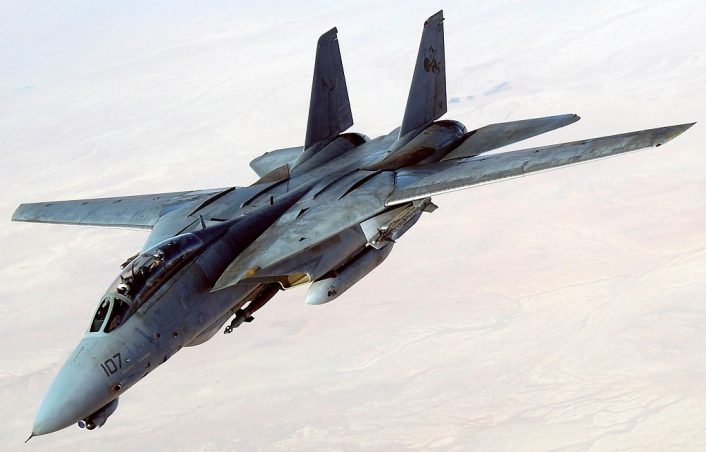
Combat Air Patrol Cat Fights
On August 19, 1981, two F-14s were engaged by Libyan Sukhoi Su-22 “Fitters” over the Gulf of Sidra in the Mediterranean Sea. In what became known as the Gulf of Sidra incident, the Tomcats from VF-41”Black Aces,” operating from the carrier USS Nimitz, were able to evade the hostile missile fired at them and returned fire splashing both Libyan aircraft.
The American aircraft were flying CAP (Combat Air Patrol) while a Lockheed S-3A Viking ran a pattern over international waters that were contested by Libyan leader Gaddafi as belonging to Libya. Both Su-22s were destroyed by hits in the tailpipe from heat-seeking AIM-9 Sidewinder missiles. It was the first aerial victories for the F-14 as well as a historical first of all aircraft involved being of variable-geometry designs.
Shortly after the incident two MiG-25 “Foxbat” aircraft operated by Libya headed towards Nimitz with F-14s turning them back, then once the F-14s turned for home, the MiGs turned back towards the carrier only to be chased away once more.
Jan. 4, 1989 saw the Libyans once again throw variable-geometry aircraft against American F-14s in a second incident over the Gulf of Sidra, when a pair of MiG-23 Floggers was downed in the Mediterranean Sea north of Tobruk, Libya. Two pairs of F-14s were conducting combat air patrols while operating from the carrier USS John F. Kennedy, when a Grumman E-2 Hawkeye detected the MiGs departure from an airfield near Tobruk and heading north toward the carrier battle group.
One pair of Tomcats operating with VF-32 was directed to intercept the MiGs while another pair of F-14s from VF-14 flew cover for Grumman A-6 Intruder aircraft operating in the area. The intercepting F-14s began tracking the Floggers 72 nautical miles away but, unlike most previous encounters with Libyan pilots, the two MiGs did not turn back once detecting the radar sweeps from the Tomcats.
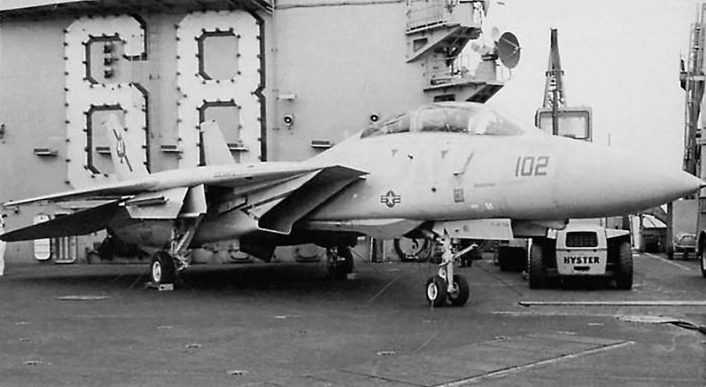
The two pairs of aircraft continued to converge head on, and despite multiple maneuvers, the MiGs insisted on placing themselves on head-on approaches to the American aircraft. With the MiGs consistently showing aggression, they were determined hostile and one was shot down with an AIM-7 Sparrow, followed by the second MiG being downed by an AIM-9.
During Operation Desert Storm in 1991, Tomcats performed CAP duties over the Red Sea as well as the Persian Gulf, along with strike escort missions and reconnaissance roles. With strict Rules of Engagement, the F-14 was limited in utilizing BVR weapons such as the AIM-7 and the AIM-54; however the AWG-9 radar emissions frequently sent Iraqi aircraft retreating at a great range once they were “lit up.”
On Jan. 21, 1991 the F-14 suffered its only loss to enemy action when one was hit with an SA-2 surface-to-air missile near Al Asad airbase in Iraq. The F-14 shared the skies with Air Force McDonnell Douglas F-15s conducting air combat patrols. A Mi-8 helicopter would be the final kill for a United States Navy F-14 when it was downed with an AIM-9 on Feb. 6.
Nicknamed “Bombcats,” F-14s finished out their career utilizing enhanced ground attack capabilities in Bosnia during Operation Deliberate Force, in Operation Enduring Freedom in Afghanistan, and in Operation Iraqi Freedom. They performed these duties well and also helped enforce “no-fly zones.” However, the Tomcat’s career was coming to a close.
Stray Cats
Despite attempts to market the F-14 abroad, only one nation besides the United States purchased the F-14. Originally sold to the Imperial Iranian Air Force in the 1970s, the Shah of Iran was deposed from power leaving these potent aircraft and their Phoenix missiles in the hands of the Islamic Republic of Iran Air Force (IRIAF) in 1979.
Although not involved in fleet defense roles, Iran used the aircraft and the AIM-54 with good success during the Iran-Iraq War 1980-1989. Out of the original 79 purchased, small numbers of Iranian F-14s are thought to still be airworthy despite the lack of spare parts due to American sanctions, and at the time of this writing it is unclear how they have fared in the recent conflict with Israel.
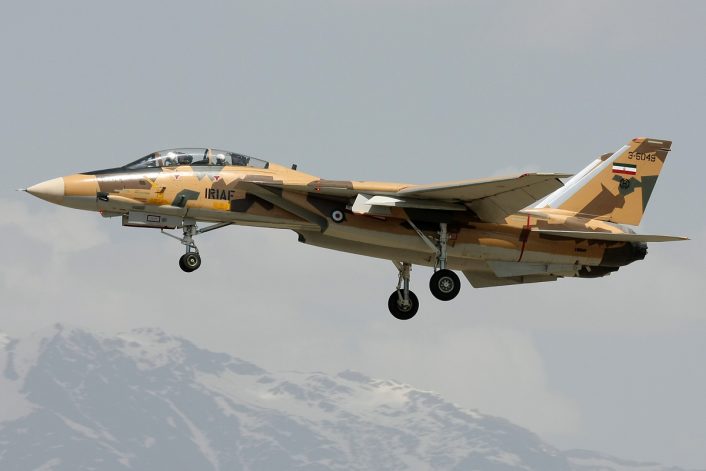
Putting the Cat out
Despite performing well and having extremely potent and effective weapons and capabilities for fleet air defense, the F-14 Tomcat was retired from active service with the Navy on Sept. 22, 2006 at NAS (Naval Air Station) Oceana, Virginia, after Grumman had produced a total of 710 aircraft. The potent AIM-54 Phoenix missile was retired previously in 2004. The last flight for an F-14 in U.S. service was on Oct. 4, 2006.
The Tomcat had become very expensive to maintain and being a mostly analog plane in a digital world, it was replaced by the Boeing F/A-18E/F Super Hornet that is capable of carrying the new AIM-174 “Gunslinger” long range AAM. Many F-14s are now on display in museums and parks with engines and critical components removed in order to prevent parts being harvested and used by the Iranians to keep their F-14s in service. Made famous by the popular 1986 Top Gun movie, the legendary Tomcat is well recognized and loved by both movie goers and aviation enthusiasts everywhere.


